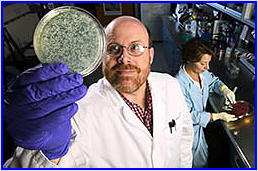



Natural Substance Reduces Campylobacter in Chickens
US - Proteins called bacteriocins, produced by bacteria, can reduce Campylobacter pathogens to very low levels in chicken intestines and could help reduce human exposure to food-borne pathogens, Agricultural Research Service (ARS) scientists report.
Natural Substance Reduces Campylobacter in Chickens - US - Proteins called bacteriocins, produced by bacteria, can reduce Campylobacter pathogens to very low levels in chicken intestines and could help reduce human exposure to food-borne pathogens, Agricultural Research Service (ARS) scientists report.
Bruce Seal, research leader for the Poultry Microbiological Safety Research Unit in Athens, is directing the work on reducing food-borne bacterial pathogens like Campylobacter. The research was begun by ARS microbiologist Norman Stern in Athens. Stern was awarded a patent on uses for bacteriocins. He and colleagues Greg Siragusa and Eric Line have applied for several other patents as well.
The work was completed in collaboration with Edward Svetoch, a Russian Federation scientist at the State Research Center for Applied Microbiology in Obolensk. Svetoch and Stern evaluated tens of thousands of bacterial isolates from poultry production environments. Stern and his colleagues have found promise in numerous organisms for anti-Campylobacter activity, namely Bacillus circulans and Paenibacillus polymyxa.
In addition, Stern and his colleagues successfully enhanced the production of bacteriocins, making it much more attractive for industrial testing. According to Stern, there has been substantial industry interest in licensing the technology. Bacteriocins could become an alternative to antibiotics for protecting poultry.
The current research is funded and coordinated by the U.S. Department of State, the International Science and Technology Center, and the ARS Office of International Research Programs.
Source: USDA Agricultural Research Service - 16th November 2005
The research was coordinated by scientists at the ARS Richard B. Russell Research Center in Athens, Ga. They collaborated with scientists from the former Soviet Union on this and other food safety research.
In a chicken’s gut, the bacteriocins can crowd out pathogenic bacteria, making it less likely that pathogens could infect poultry or humans.
 |
| Microbiologist Gregory Siragusa examines a bacterial culture while technician Johnna Garrish measures zones of antimicrobial activity against bacteria from bacteriocin agents co-developed by U.S. and Russian scientists. |
The work was completed in collaboration with Edward Svetoch, a Russian Federation scientist at the State Research Center for Applied Microbiology in Obolensk. Svetoch and Stern evaluated tens of thousands of bacterial isolates from poultry production environments. Stern and his colleagues have found promise in numerous organisms for anti-Campylobacter activity, namely Bacillus circulans and Paenibacillus polymyxa.
In addition, Stern and his colleagues successfully enhanced the production of bacteriocins, making it much more attractive for industrial testing. According to Stern, there has been substantial industry interest in licensing the technology. Bacteriocins could become an alternative to antibiotics for protecting poultry.
The current research is funded and coordinated by the U.S. Department of State, the International Science and Technology Center, and the ARS Office of International Research Programs.
Source: USDA Agricultural Research Service - 16th November 2005








